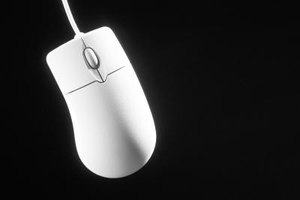What Is the Function of a Computer Mouse?
by DoZ_MaN
The computer mouse was one of the earliest PC peripherals, and it's still going strong as a constant companion of the keyboard. While the keyboard is set up for typing, the mouse is designed for pointing and clicking around a graphical user interface, such as those used by Windows or the Mac OS, as well as by the many applications that run on those operating systems.
Main Functions
A computer mouse enables its user to move a cursor smoothly and intuitively across a two-dimensional plane. It's therefore an essential input device for selecting, dragging, hovering, and clicking. The mouse allows users to switch between applications, select options and buttons, and move around the screen with a great degree of accuracy and fluidity. It is used to move between and select links on a website, buttons on an options screen, entries on a menu, and many more tasks that would be far more difficult using a keyboard alone.
Other Functions
Most mice come with a left button, a right button, and a scroll wheel. Not only does the mouse enable moving and selecting with the left mouse button, it can also be used to bring up alternative functions and menus by clicking the right button when hovering over a screen element. The mouse lets users zoom in and out quickly, and scroll up and down using the scroll wheel located between the two buttons. Advanced mice have extra buttons placed around the casing that can be assigned tasks and functions specific to the operating system or a particular program.
Examples of Use
A computer mouse really comes into its own when a high degree of accuracy is important. Image-editing programs that require detailed selections, and games where fine on-screen movements are necessary are two situations where a mouse can prove very useful. A mouse is a key peripheral in any program and the operating system itself, but it is essential for such creative applications as image, video, and music editing; it's also standard equipment for many games titles, desktop publishing, and presentation software.
Mouse Specifications
Most mice connect to a computer via a USB cable or a wireless USB dongle. Many come with additional buttons that are useful for creative professionals and gamers. Optical laser technology has taken over from the traditional track-and-ball method of measuring a mouse's movement. More expensive models offer a higher sensitivity rate (measured in dots per inch) for tracking very slight changes in position. While the standard mouse design has not altered much down the years, more ergonomic models are available that are designed to fit the hand more comfortably.
About the Author
An information technology journalist since 2002, David Nield writes about the Web, technology, hardware and software. He is an experienced editor, proofreader and copywriter for online publications such as CNET, TechRadar and Gizmodo. Nield holds a Bachelor of Arts in English literature and lives in Manchester, England.








No comments:
Post a Comment